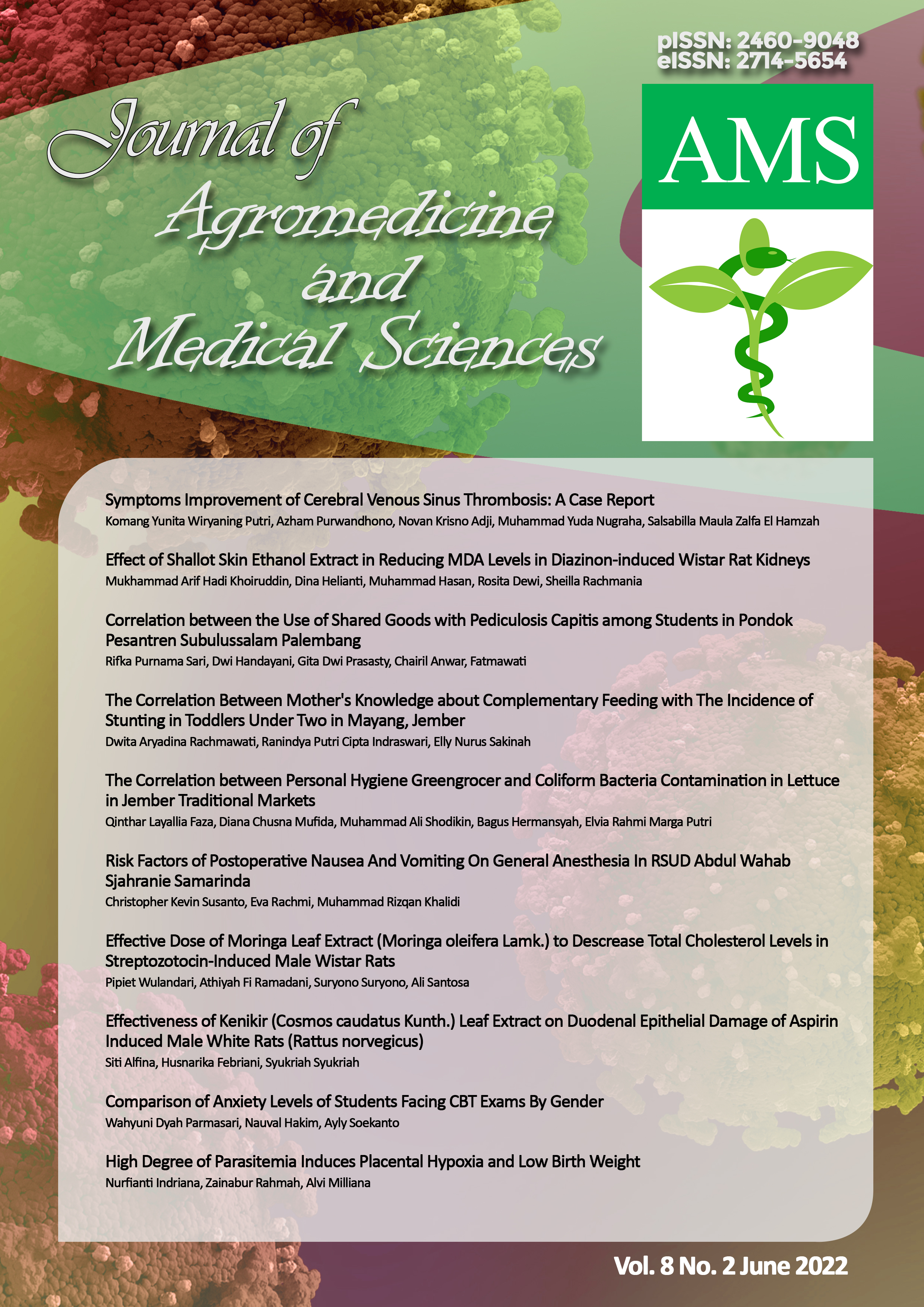High Degree of Parasitemia Induces Placental Hypoxia and Low Birth Weight
DOI:
https://doi.org/10.19184/ams.v8i2.31243Abstract
Placental malaria causes low fetal weight associated with infiltration of monocytes and parasites in the placenta resulting in placental hypoxia. Hypoxia is characterized by HIF expression. HIF-1α expression responds early to the occurrence of hypoxia (<24 hours) and HIF-2α promotes chronic hypoxia (>24 hours). There were two groups in this study, namely the control group (10 pregnant mice without Plasmodium berghei infection) and the treatment group (10 pregnant mice infected with Plasmodium berghei). Pregnant mice were operated on on the 18th day after mating. The degree of parasitemia was measured by Giemsa staining. Expression of HIF-1α and HIF-2α in placental tissue was measured by immunohistochemistry. Results by paired t test, HIF-1α expression in the placental tissue in the treatment group was higher than the control group (p=0.02), HIF-2α expression in the placental tissue was higher in the treatment group than in the control group (0, 01) the fetal weight in the treatment group was lower than in the control group (p=0.01). By using SEM analysis, the degree of parasitemia caused high expression of HIF-1α in placental tissue (tcount = 4.625, ttable = 1.96). High expression of HIF-2α in placental tissue (tcount = 2.672 ttable = 1.96). The degree of parasitemia causes low fetal weight (tcount = 27.764 ttable = 1.96). The results also showed that HIF-1 caused low birth weight (tcount = 2.376 ttable=1.96) also HIF-2α caused low fetal weight (tcount = 4.267 ≥ 1.96). Conclusions the degree of parasitemia causes high expression of HIF-1α and HIF-2α in placental tissue and low birth fetuses. Expression of HIF-1α and HIF-2 also causes low birth weight.
Keywords: malaria in pregnancy, degree of parasitemia, HIF-1α , HIF-2α , birth weight
Downloads
References
Bhaskar, A., & Tiwary, B. N. (2016). Hypoxia inducible factor-1 alpha and multiple myeloma. International Journal of Advanced Research, 4(1), 706. /pmc/articles/PMC4760640/
Cardona-Arias, J. A., & Carmona-Fonseca, J. (2022). Frequency of placental malaria and its associated factors in northwestern Colombia, pooled analysis 2009-2020. PloS One, 17(5), e0268949. https://doi.org/10.1371/JOURNAL.PONE.0268949
Chua, C. L. L., Hasang, W., Rogerson, S. J., & Teo, A. (2021). Poor Birth Outcomes in Malaria in Pregnancy: Recent Insights Into Mechanisms and Prevention Approaches. Frontiers in Immunology, 12, 621382. https://doi.org/10.3389/FIMMU.2021.621382
Doritchamou, J., Sossou-tchatcha, S., Cottrell, G., Moussiliou, A., Hounton Houngbeme, C., Massougbodji, A., Deloron, P., & Tuikue Ndam, N. (2014). Dynamics in the Cytoadherence Phenotypes of Plasmodium falciparum Infected Erythrocytes Isolated during Pregnancy. PLoS ONE, 9(6). https://doi.org/10.1371/JOURNAL.PONE.0098577
Hviid, L. (2010). The role of Plasmodium falciparum variant surface antigens in protective immunity and vaccine development. Human Vaccines, 6(1), 84–89. https://doi.org/10.4161/HV.6.1.9602
Kierans, S. J., & Taylor, C. T. (2021). Regulation of glycolysis by the hypoxia-inducible factor (HIF): implications for cellular physiology. The Journal of Physiology, 599(1), 23–37. https://doi.org/10.1113/JP280572
Koh, M. Y., & Powis, G. (2012). Passing the baton: the HIF switch. Trends in Biochemical Sciences, 37(9), 364–372. https://doi.org/10.1016/J.TIBS.2012.06.004
Kumar, R., Ng, S., & Engwerda, C. (2019). The Role of IL-10 in Malaria: A Double Edged Sword. Frontiers in Immunology, 10(FEB), 229. https://doi.org/10.3389/FIMMU.2019.00229
Omer, S., Franco-Jarava, C., Noureldien, A., Omer, M., Abdelrahim, M., Molina, I., & Adam, I. (2021). Impact of placental malaria on maternal, placental and fetal cord responses and its role in pregnancy outcomes in women from Blue Nile State, Sudan. Malaria Journal, 20(1), 1–8. https://doi.org/10.1186/S12936-021-03580-X/TABLES/5
Omotayo, R. S., Akintan, A. L., Akadiri, O., Bade-Adefioye, A. M., & Omotayo, S. E. (2020). Level of awareness of primigravida about pregnancy and antenatal care at the time of booking in a South West Nigerian tertiary hospital. International Research Journal of Medicine and Medical Sciences, 8(3), 83–96. https://doi.org/10.30918/IRJMMS.83.20.029
Rahmah, Z., Wahju-Sardjono, T., Enggar-Fitri, L., Ulfiati, A., Ungu, B., Zulhaidah-Arthamin, M., & Norahmawati, E. (2019). Accumulation of CD4 and CD8 T Cells in Placenta of Malaria Infected Mice Induces the Expression of Hypoxia Inducible Factor-1α (HIF-1α) and Low Birth Weight (LBW) of the Fetus. Iranian Journal of Parasitology, 14(4), 604. /pmc/articles/PMC7028234/
Sharma, L., & Shukla, G. (2017). Placental Malaria: A New Insight into the Pathophysiology. Frontiers in Medicine, 4(JUL). https://doi.org/10.3389/FMED.2017.00117
Wang, W., Wang, Z., Yang, X., Gao, Y., Zhang, X., Cao, L., Dai, A., Sun, J., Sun, L., Jiang, L., Chen, Z., & Wang, L. (2021). The molecular mechanism of cytoadherence to placental or tumor cells through VAR2CSA from Plasmodium falciparum. Cell Discovery, 7(1), 94. https://doi.org/10.1038/S41421-021-00324-8
World Health Organization. (2020). World Malaria Report: 20 years of global progress and challenges. World Health Organization, 300. https://www.who.int/publications/i/item/9789240015791
Zheng, F., Chen, J., Zhang, X., Wang, Z., Chen, J., Lin, X., Huang, H., Fu, W., Liang, J., Wu, W., Li, B., Yao, H., Hu, H., & Song, E. (2021). The HIF-1α antisense long non-coding RNA drives a positive feedback loop of HIF-1α mediated transactivation and glycolysis. Nature Communications 2021 12:1, 12(1), 1–20. https://doi.org/10.1038/s41467-021-21535-3






















